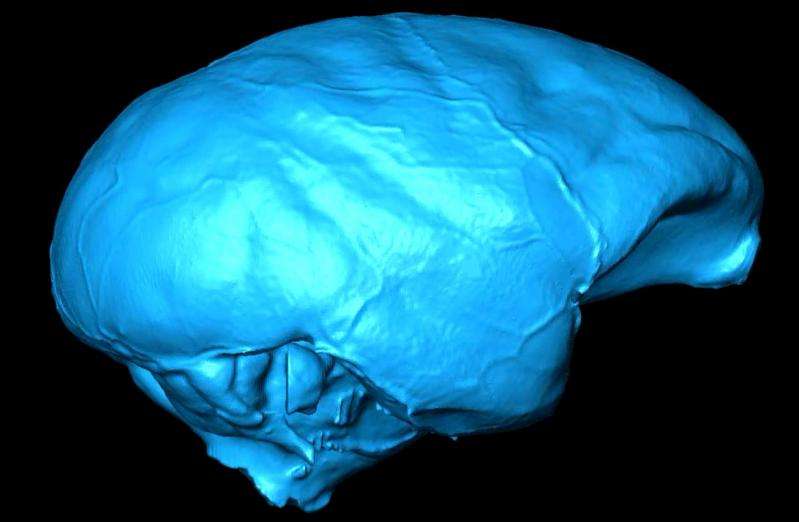February 9, 2016 report
Monkey skull study suggests brain evolved in spurts

(Phys.org)—A small team of researchers from Brazil and Argentina has found via skull analysis and modeling that a kind of new-world monkey appears to have undergone changes in individual parts of its brain during evolutionary periods which led to advances in cognitive development. In their paper published in Proceedings of the National Academy of Sciences, the team describes their study and results and why they believe what they found might apply to humans as well.
For many years, researchers believed that superior intelligence in humans was attributable to our brain size—that the large size of our brain relative to the size of the rest of our body was what set us apart. But subsequent studies found that other animals had ratios that were even more pronounced than ours, suggest thing it must be something else. In this new study, the researchers propose that it was changes to the size of certain parts of the brain that led to increases in cognitive abilities, and that it happened in spurts.
The team came to these conclusions by studying the skulls of 179 adult platyrrhines (which included 49 species and samples of both genders)—a type of new world monkey. The researchers added data from the skulls into modeling software that was also able to take into account evolutionary changes. In studying the models, the researchers found that the brains of the monkeys underwent two distinct periods of evolutionary change. The first came about as the monkeys began moving around on the ground more, allowing them to obtain new types of food. That led, the researchers assert, to an enlarged neocortex, which forced the brain to shift on its axis, pushing the brain stem farther down. The next spurt came about, they believe when the monkeys became more social—that led to a less expanded prefrontal area. The models showed that the brain changed to meet changing circumstances, the team suggests, eventually leading to the shape the monkeys have now.
Because humans are also primates, the researchers suggest that it seems reasonable to conclude that our brains grew in spurts as well during similar situations of our history, and because of that suggest that it was not just growth in overall brain size that led to our superior intellect, but the growth of certain parts that were used heavily as we evolved.
More information: Brain shape convergence in the adaptive radiation of New World monkeys, Leandro Aristide, DOI: 10.1073/pnas.1514473113 , www.pnas.org/content/early/2016/02/04/1514473113
Abstract
Primates constitute one of the most diverse mammalian clades, and a notable feature of their diversification is the evolution of brain morphology. However, the evolutionary processes and ecological factors behind these changes are largely unknown. In this work, we investigate brain shape diversification of New World monkeys during their adaptive radiation in relation to different ecological dimensions. Our results reveal that brain diversification in this clade can be explained by invoking a model of adaptive peak shifts to unique and shared optima, defined by a multidimensional ecological niche hypothesis. Particularly, we show that the evolution of convergent brain phenotypes may be related to ecological factors associated with group size (e.g., social complexity). Together, our results highlight the complexity of brain evolution and the ecological significance of brain shape changes during the evolutionary diversification of a primate clade.
Journal information: Proceedings of the National Academy of Sciences
© 2016 Phys.org





















